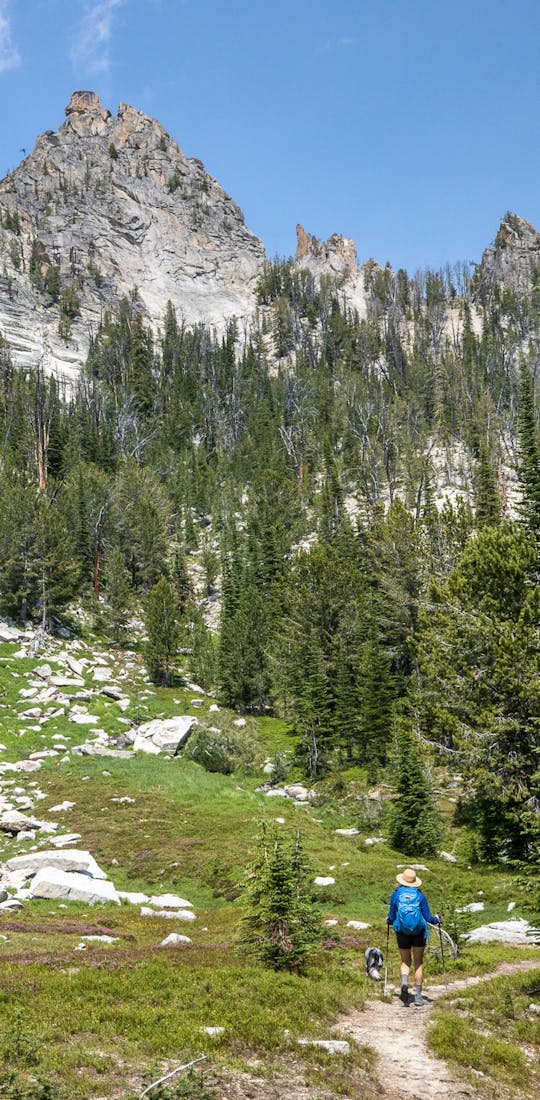You've probably heard the phrase "Leave No Trace"
But what exactly does it mean? In a nutshell, Leave No Trace (LNT) refers to a set of principles that guide our interactions with the outdoors to minimize our environmental impact. It’s a vital “code of conduct” that helps us preserve nature and keep the wilderness wild for generations to come.
In this blog post, we're going to cover the Leave No Trace principles as they relate to hiking so you can reduce your impact on the trail - something that's essential but often misunderstood.
Why is Leave No Trace so important for hikers and backpackers you might ask? Simply put, our beloved trails, parks, and wilderness areas are under threat from increased use. Following the Leave No Trace principles helps protect these wilderness areas, ensuring they remain beautiful and accessible for all.
So, let's dive into the 7 LNT principles and learn how you can implement them during day hikes and backpacking trips!
- Plan Ahead and Prepare
Any successful hiking or backpacking trip begins with thorough planning and preparation. This means researching the trail in advance to know what to expect. Here’s a few questions to keep in mind:
- Are there bathrooms or water at the trailhead?
- What sort of wildlife inhabits the area, and how should you store your food accordingly?
- Are there fire bans in place?
- What’s the weather forecast?
The more you know, the better equipped you'll be to respect the environment and have a safe, enjoyable adventure. - Stay On Trail & Minimize Your Impact
Veering off the trail can lead to trampling plants, disturbing wildlife habitats, and causing soil erosion. While it might be tempting to blaze your own trail or take a shortcut, remember that existing trails are there for a reason. By sticking to them, you help preserve the delicate ecosystems that make the wilderness so magical.
If you’re backpacking, look for existing campsites to pitch your tent instead of creating a new site. Be sure to camp at least 200ft (about 70 big steps) from any water source. Brush up on any area restrictions such as fire bans and how to properly dispose of waste. - Dispose of (All) Waste Properly
An easy LNT phrase to remember is “pack it in, pack it out” — it’s important to leave places as good (if not better) than we found them, which means not leaving any garbage behind. Bring along a small Ziplock or trash bag for your trash, and if you can, take it a step further and consider picking up litter you find along the way.
And remember: organic waste is still waste! Items like orange peels and pistachio shells can take years (sometimes up to 2 years for an orange peel and 3 years for a pistachio shell!) to biodegrade, which can disrupt local ecosystems and take away from the pristine beauty of a place.
Disposing of your waste properly also means knowing how to responsibly use the bathroom outdoors. That means going somewhere off trail, but least 200 ft. away from any water source. If you need to go #2, dig a cathole at least 6-8in. deep to do your business, bury it, and be sure to pack out your toilet paper (no one wants to see used TP in the bushes!) We recommend always bringing along a poop kit with a lightweight trowel, some TP, and a ziploc bag just in case. In sensitive desert environments, digging a hole may not be appropriate in which case you will need to pack out your waste using Wag Bags (basically, a bag specifically designed for human waste).
Be sure to pick up after your pets too and dispose of your dog poop bags appropriately. - Leave What You Find
Ever heard of the saying, "Take only pictures, leave only footprints"? It perfectly encapsulates this principle. Whether it's an attractive rock, a shell, or a beautiful flower, resist the urge to take it as a souvenir. By leaving what you find, you're helping to preserve the natural environment and allowing others to enjoy its beauty too. - Minimize Campfire Impacts
If you're planning an overnight trip, it's crucial to understand how to minimize your campfire impact. Always be sure to check local restrictions to ensure campfires are allowed.
Wherever possible, use a camp stove for cooking rather than making a fire. If you must have a fire, use established fire rings, keep fires small, and burn only dead sticks and branches from the ground. And of course, always ensure your fire is completely extinguished before leaving camp. - Respect Wildlife
Knowing what kind of wildlife lives in the area you're hiking is essential. Not just for your safety, but also for the well-being of the animals.
Be sure to store your food properly and keep it out of reach of animals. Don’t leave your food and gear unattended as well - we’ve heard of squirrels and marmots chewing through backpacks to get the food inside.
Keep your distance from wildlife so you don’t disturb them, and use binoculars if you want to get a closer look. And as tempting as it might be, never feed wild animals! Doing so can damage their health and alter natural behaviors. - Be Considerate of Others
Finally, remember that the great outdoors is a shared space. Keep noise levels down, leave your Bluetooth speaker at home, yield to other hikers on the trail, and generally be aware of your impact on others' experiences. A friendly nod or a cheerful "hello" can go a long way in promoting a positive trail culture.
The Leave No Trace principles are more than just guidelines — they're a commitment to preserving our natural world and respecting others who enjoy it. By incorporating these principles into your hiking and backpacking adventures, we can each play a part in ensuring the longevity of our beloved outdoor spaces. Happy trails!

